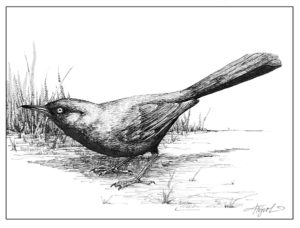By Meghan McCarthy McPhaul
The grackle appeared early last spring, the day before I put the feeder away (so as not to tempt the bears who would soon be awakening from their winter dens). In the dim light of a cloudy day, this avian visitor seemed at first to be just another blackbird, on the larger side, perhaps, and with a longer-than-usual tail. When I peered at him through the binoculars, however, his head and neck shimmered with iridescent blues and purples, and there seemed to be a greenish tinge to his wings.

I watched for a few minutes as the bird perched awkwardly to snag seeds, then flew off to the nearby serviceberry tree. His feathers and pale-yellow eyes gleamed through a spring snow squall. His size among the considerably more diminutive chickadees and song sparrows at the feeder that day made the grackle a standout — a character, you might say. He seemed a bit like a discreetly colorful player on the avian stage.
Like many of the birds in my yard that week, the grackle had recently arrived from winter digs in a slightly more southern realm. In the grackle’s case, those would likely have been in the mid-Atlantic region or farther south. And while this bird had escaped my notice until now, the common grackle is, indeed, rather common in New England. In fact, once I noticed that first grackle, I started spotting them in other places — gathering noisily in a neighbor’s shrubbery and strutting across the lawn of a local eatery.
“Basically, if you are in an open landscape with woodlots, hedgerows, and water, you will have a hard time NOT finding grackles,” said ornithologist Walter Ellison, the breeding bird atlas coordinator for Maryland’s Kent County. “In heavily wooded areas, they will be along larger flatwater swampy streams and around ponds, including isolated beaver ponds.”
The grackle’s song is short and not-so-sweet, at least to the human ear. It’s more guttural than musical. One apt description I found compared it to the noise of a rusty gate creaking open. Despite the brevity of their song, grackles are gregarious and make a variety of other nasal calls when alarmed, or when approaching other grackles. The birds will often build their nests close to other common grackles, although they are not as colonial as boat-tailed and great-tailed grackles, which breed outside of our region.
At this time of year, grackles are beginning or preparing for fall migration. The common grackle is one of several bird species whose head, beak, and neck contain magnetite, which may allow these birds to use the earth’s geomagnetic fields to help navigate. Many of them will fly southward in large, mixed flocks, joined by red-winged blackbirds, cowbirds, and robins. At night, they will gather in large communal roosts, some numbering more than 200,000 birds.
Ellison noted that in the 1970s and 1980s, common grackle tallies during the annual Christmas Bird Count in the southern states numbered more than a million birds, but those numbers have been declining, in large part due to pest control measures.
Common grackles have a varied diet, which includes — to the annoyance of many a farmer — corn. But they are opportunistic eaters by season and location. “They eat more grain and mast in winter and more insects and invertebrates in the warm months,” Ellison said. “They feed mostly on earthworms, aquatic insect larvae, and large terrestrial insects such as grasshoppers and dragonflies in summer. Grackles will also eat nestling birds, small amphibians and reptiles, small mammals, and small songbirds if the opportunity arises, but these are hard to come by and only a rare part of the menu.” As for the shimmering colors of the common grackle’s feathers, Ellison compares that to the way we might distinguish colors in oily water. “Grackle feathers have huge numbers of tiny, colorless, transparent bead-like structures in layers backed by a layer of black melanin beads that reflect light in certain wavelengths,” he said. “As such, the colors can vary depending on the angle of light and the position of an observer. For instance, the head of a grackle can vary from steel blue to dark green as it turns its head in full sunlight.”
Whether those feather colors are shifting and shimmering through springtime snow or summer sunlight, the common grackle is a bird I’m happy to have discovered.
Meghan McCarthy McPhaul is assistant editor for Northern Woodlands. The illustration for this column is by Adelaide Murphy Tyrol. The Outside Story is assigned and edited by Northern Woodlands magazine and sponsored by the Wellborn Ecology Fund of the New Hampshire Charitable Foundation: nhcf.org.




